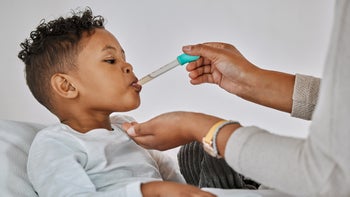
Is Your Toddler Getting a Flu Shot? Here Are Some Side Effects to Watch for
Key takeaways:
The flu vaccine can keep toddlers from developing severe flu illness and needing care in the hospital.
Mild flu shot side effects are common among toddlers. The most common flu shot side effects in toddlers are redness and pain at the injection site.
Flu shot side effects go away on their own, and most toddlers don’t need any medication or special treatment.

Cold and flu season can seem like a never-ending parade of illnesses, especially if you have a toddler at home. Thankfully, flu vaccines can lower your family’s risk of yet another illness during those winter months. The flu shot is available to everyone 6 months and older. On average, flu vaccines lower your risk of getting sick from the flu by 40% to 60%. And young children and toddlers who get their flu shot are almost half as likely to need an emergency room visit or hospitalization if they get sick with the flu.
But some parents and caregivers are hesitant about flu shot side effects. The good news is that most toddlers experience only mild side effects when they get the flu vaccine — if they experience any at all. Here’s what you should know about the most common flu shot side effects in toddlers and how to keep your little one comfortable after their vaccine.
What are the side effects of the flu vaccine?
The flu vaccine is safe. But there are many myths and urban legends about the flu shot. Fortunately, most of these aren’t true. For example, the flu shot can’t make you sick and you can’t “catch the flu” from the flu shot either.
Search and compare options
But, just like any medicine, the flu shot can cause side effects in kids. The following are four side effects to be aware of.
1. Pain
Pain or tenderness at the injection site is the most common side effect in toddlers. This isn’t from the needle going into your child’s arm. It’s actually from the liquid that makes up the vaccine. When the liquid gets injected into your muscle tissue, it stretches your muscle a little bit. This causes a small amount of inflammation and discomfort. Luckily, there’s only 0.25 mL of liquid in a toddler flu vaccine. That’s just a fraction of a teaspoon. So the body is able to adjust very quickly, and the soreness wears off within 1 to 2 days.
You can help soothe soreness with an ice pack. Place the ice pack on your child’s arm for about 5 to 10 minutes a few times throughout the day after they get their flu shot. Make sure to wrap ice or ice packs in a cloth before placing it on your child’s skin. You can also give your child’s arm a gentle massage before they go to sleep.
2. Redness
Skin redness around the injection site is another common side effect after the flu vaccine. Many parents and caregivers worry that this can be a sign of infection. But it’s actually an injection site reaction. An injection site reaction develops because the vaccine can irritate your skin or the tissue underneath your skin. The vaccine also triggers your immune system to start working. When the immune system first kicks off, it can also cause an immune-mediated reaction. This makes your skin turn pink or red.
Skin redness usually develops a few hours after your toddler gets their vaccine. But it can take a day or two to see these skin changes. Most toddlers aren’t bothered by this side effect, so you don’t have to do anything to help the redness go away. And the skin will go back to its normal color over the next 3 to 5 days.
3. Fever
Some toddlers develop a fever after the flu vaccine. And in this case, it’s a good sign. Fever is a sign that the immune system has recognized the vaccine and is building antibodies that will keep your toddler safe from the flu.
Read more like this
Explore these related articles, suggested for readers like you.
Fevers usually start the same day as the vaccine and last about 24 hours. In one study, children who got the flu shot only experienced fevers for 6 hours on average. Your child’s fever should be less than 101°F. Call your child’s primary care provider if they have a high fever or if their fever lasts longer than 24 hours. These are signs that the fever can be from something besides the flu shot.
You don’t need to treat a fever from the flu shot. But if your child is uncomfortable or irritable, you can try over-the-counter (OTC) fever relievers like children’s acetaminophen (Children’s Tylenol) or children’s ibuprofen (Children’s Motrin).
4. Irritability
Some toddlers can get cranky after receiving the flu vaccine. This is usually from soreness or pain in their arm where they got their flu shot. Fevers can also make your child irritable. Treating your toddler’s pain and fever can help ease their irritability, too. Most toddlers will be back to their usual selves by morning. Call your child’s primary care provider if your toddler is still more cranky than usual the next day.
Can you give a toddler Motrin or other medicine after a flu shot?
Yes. If your child has muscle soreness, fever, or crankiness, it’s OK to give acetaminophen or ibuprofen. Make sure to follow all dosing instructions on the packaging. Your child’s primary care provider can also provide you with dosing information if you’re not sure what dose to give your child.
But there are ways to help your child’s symptoms without using medication. If you prefer to avoid medication, you can try cold compresses to ease soreness and encourage your child to get plenty of rest.
It may seem like a good idea to give your child a dose of ibuprofen or acetaminophen before their flu shot. But some studies suggest that giving these medications may lower the body’s ability to respond to the vaccine. Most experts urge parents and caregivers not to give a dose of pain and fever reducers before a vaccine. But rest assured that giving these medications after a vaccine won’t affect your child’s immune response.
When should you see a healthcare professional about flu shot side effects?
Severe vaccine reactions are very rare. But some children do develop severe side effects and allergic reactions to flu vaccines. Seek immediate medical care or call 911 if your child has:
Difficulty breathing
Wheezing
Voice changes (hoarseness)
Swelling of the face, tongue, or neck
Hives
High fevers
Weakness or dizziness
Fast heart rate
Loss of skin color or paleness of the skin
Flu shots have also been linked to Guillain-Barré syndrome. But this is very rare. The risk is about one in a million.
Symptoms of Guillain-Barré syndrome include:
Pins and needles, tingling, or burning sensation in your hands or feet
Weakness
Trouble feeling touch
Seek immediate medical care if you notice any weakness or your child complains of unusual symptoms.
The bottom line
Getting your toddler vaccinated against the flu can keep them safe from serious flu illness. The flu shot can cause side effects in toddlers. These side effects are usually mild and short-lived. The most common are soreness and redness at the injection site. Some toddlers develop low-grade fevers and crankiness too. Most children feel back to normal within 24 hours. You can help ease their symptoms with rest, fluids, and comfort. OTC pain and fever relievers can also help reduce symptoms.
Why trust our experts?


References
Ahn, S. H., et al. (2019). Postvaccination fever response rates in children derived using the fever coach mobile app: A retrospective observational study. JMIR Mhealth Uhealth.
Centers for Disease Control and Prevention. (2019). Vaccine for flu (influenza).
Centers for Disease Control and Prevention. (2023). Clinical immunization safety assessment (CISA) clinical research studies.
Centers for Disease Control and Prevention. (2023). Flu vaccine safety information.
Centers for Disease Control and Prevention. (2023). New study shows flu vaccination cut urgent care and emergency department visits and hospitalizations in kids by nearly half.
Centers for Disease Control and Prevention. (2023). Vaccine effectiveness: How well do flu vaccines work?
Centers for Disease Control and Prevention. (2024). Seasonal flu vaccines.
Children’s Hospital of Philadelphia. (2024). Fever and vaccines.
Golen, T. (2022). Why does my arm hurt after I get a shot? Harvard Health Publishing.
McCarthy, C. (2023). 10 things parents should know about flu shots. Harvard Health Publishing.
Saleh, E., et al. (2016). Effect of antipyretic analgesics on immune responses to vaccination. Human Vaccines and Immunotherapeutics.





























